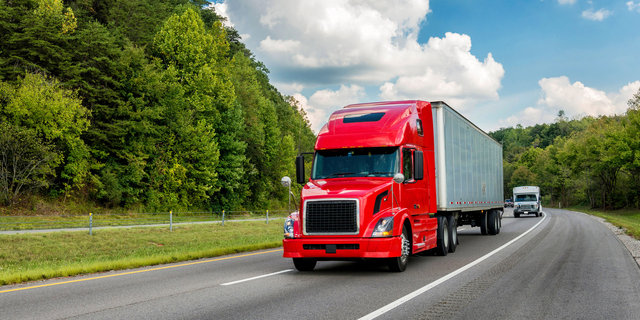
January 3, 2023
The Pros & Cons of Truck Shipping: Cost, Speed, Capacity and More
Trying to navigate the world of freight transportation can be tricky. With so many moving parts (literally!), it can be tough to know which transportation mode is best for shipping your freight.
One way to simplify the choice is to compare the cost, speed, capacity, reliability and environmental impact of each transportation mode. If that sounds like a lot of work, don't worry. We're doing the work for you. In our transportation mode comparison series, we explore the pros and cons of the most popular shipping modes — truck, rail, ship/barge and plane.
First up, shipping by truck.

Shipping by Truck
Truck is the most common mode of transport in the U.S. It provides quick delivery of shipments traveling short distances and can deliver just about anywhere. In many instances, it is used in conjunction with other transportation modes for first- and last-mile shipping.
PROS:
- Cost effective for shipping freight short distances
- Provides door-to-door pickup and delivery
- Extensive market reach, even to remote areas
CONS:
- Carrying capacity limited by truck size and weight restrictions
- Susceptible to delays caused by traffic jams, road construction and weather conditions
- Not as environmentally responsible as other modes
Cost
For the most part, shipping by truck is considered cost effective, particularly when transporting goods short distances. However, if you have freight shipments traveling from coast to coast, it might be worth looking at rail or other shipping modes, especially when you consider costs associated with more rolling resistance and air friction, which leads to higher fuel consumption than other transportation modes.
Speed
Trucks travel at an average speed of about 50 miles per hour (mph), offering quick delivery for short to medium distances. Trucks are also very good at delivering at a precise/specific time. Combining truck and rail allows you to achieve a more efficient and cost-effective shipping solution.
Capacity
Trucks are great if you have a fairly large amount of goods to ship. However, you are limited a bit depending on the size and weight of your shipment and the capacity of the truck, in addition to federal and state weight requirements.
Depending on the size of your shipment, you have options:
- Full Truckload (FTL) – Direct door-to-door service between two locations for one shipper. Loads are large enough to fill a trailer and typically weigh approximately 34,000 – 45,000 pounds.
- Less than Truckload (LTL) – Serves multiple customers and destinations. Loads do not fully occupy the entire trailer, allowing multiple loads from various shippers to travel together, and typically weigh under 15,000 pounds.
- Parcel – Carries very small loads and travels along complex “hub and spoke” networks to serve many different customers at one time for greater shipping efficiency. Parcel carriers include shippers like DHL, FedEx and UPS.
Reach
Thanks to a government-funded infrastructure across the entire continental U.S., trucking is the only mode that can pick up and deliver door to door almost anywhere – even reaching very remote areas.
Shipment Visibility
Many carriers provide visibility into your shipment’s journey. Most trucks are equipped with GPS tracking devices to pinpoint the exact location of your shipment in real time.
Reliability
Barring any major traffic, construction or weather delays, truck shipments – for the most part – are typically reliable and can be expected to arrive within a pre-determined timeframe.
Environmental Impact
While fast for short trips, trucks are much less fuel efficient and contribute to a greater percentage of total greenhouse gas emissions than other shipping modes.
Questions?
Answer a few questions about your shipment and a shipping expert will be in touch.
Related Articles:
- Pros and Cons of Rail Shipping
- Pros and Cons of Shipping by Air
- Pros and Cons of Shipping by Water
- Transportation Mode Pros and Cons: A Comprehensive Look